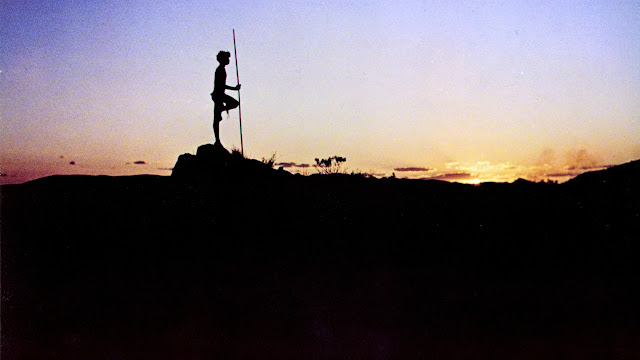Walkabout
Spoilers!
The children barely react. They forge ahead in the punishingly hot climate. The little boy complains a bit. At least they still have their radio, with its "batteries that last 400 hours", their lone tether to civilization, even as things become increasingly desperate. But it could be worse. There are no scenes of dingo attacks or hostility from the aborigines. One of them, on a walkabout ritual (where a youth must survive off the land on his own for a period of time), helps them find water and shares the spoils of his hunts. New friendship.
Roeg occasionally intercuts scenes of a research team and an arrogant artist, behaving in ways that may be considered lecherous but are entirely natural. The contrast with the main characters and their wilderness is striking, yet maybe not so dissimilar ultimately. The Aboriginal boy goes on instinct, and finds these two white city kids most curious. Doesn't seem threatened by them. He has his own natural stirrings. The girl is embarrassed when she has her period, and is well aware of the young man's desires. Her brother, perhaps also working on some primal level, finds a method of communication with the native.
WALKABOUT is a stunning, near hallucinogenic experience. Roeg, directing solo for the first time, captures a vibrant nature, complete with close ups of animals and insects, at times making the picture feel like a nature documentary. But the themes all fit, and upon reflection and repeat viewing reveal themselves. Primitive versus modern society is a repeated motif, unmistakable. You may never look at cuts in the butcher shop the same way again. Decay, inevitable. Racism and class structure, no doubt. Sexual imagery is strong; note the camera's linger even on the shape of forking tree branches. Communication and how it is misinterpreted more than bubbles under the surface. The humans may be interlopers, but long perhaps to be back in nature.
The final scene may suggest that everything in WALKABOUT is someone's hazy memory, and might explain why more unpleasant things don't happen to the unnamed girl (Jenny Agutter), her brother (Luc Roeg, Nic's son), and the Aboriginal (David Gulilil), even as the latter's exit from the film is quietly devastating. Things are remembered fondly, maybe not so accurately.




Comments